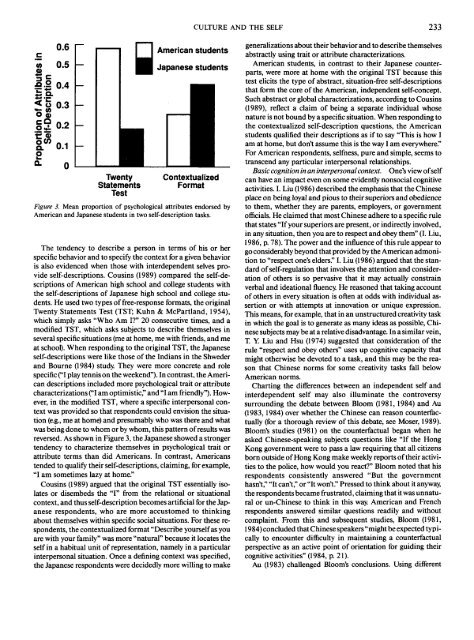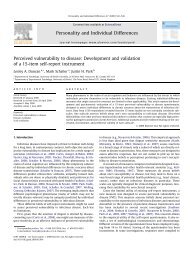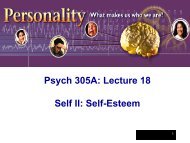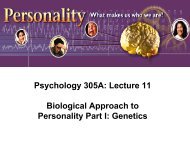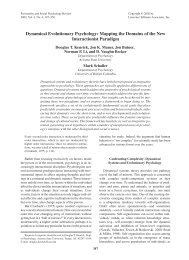Culture and the Self: Implications for Cognition, Emotion, and ... - iacmr
Culture and the Self: Implications for Cognition, Emotion, and ... - iacmr
Culture and the Self: Implications for Cognition, Emotion, and ... - iacmr
Create successful ePaper yourself
Turn your PDF publications into a flip-book with our unique Google optimized e-Paper software.
CULTURE AND THE SELF 233<br />
0.6<br />
c<br />
w 0.5<br />
§c<br />
it 0 - 4<br />
c.fr<br />
"52<br />
§2 0.2<br />
2<br />
Q.<br />
0.1<br />
0<br />
Twenty<br />
Statements<br />
Test<br />
American students<br />
Japanese students<br />
Contextualized<br />
Format<br />
Figure 3. Mean proportion of psychological attributes endorsed by<br />
American <strong>and</strong> Japanese students in two self-description tasks.<br />
The tendency to describe a person in terms of his or her<br />
specific behavior <strong>and</strong> to specify <strong>the</strong> context <strong>for</strong> a given behavior<br />
is also evidenced when those with interdependent selves provide<br />
self-descriptions. Cousins (1989) compared <strong>the</strong> self-descriptions<br />
of American high school <strong>and</strong> college students with<br />
<strong>the</strong> self-descriptions of Japanese high school <strong>and</strong> college students.<br />
He used two types of free-response <strong>for</strong>mats, <strong>the</strong> original<br />
Twenty Statements Test (TST; Kuhn & McPartl<strong>and</strong>, 1954),<br />
which simply asks "Who Am I?" 20 consecutive times, <strong>and</strong> a<br />
modified TST, which asks subjects to describe <strong>the</strong>mselves in<br />
several specific situations (me at home, me with friends, <strong>and</strong> me<br />
at school). When responding to <strong>the</strong> original TST, <strong>the</strong> Japanese<br />
self-descriptions were like those of <strong>the</strong> Indians in <strong>the</strong> Shweder<br />
<strong>and</strong> Bourne (1984) study. They were more concrete <strong>and</strong> role<br />
specific ("I play tennis on <strong>the</strong> weekend"). In contrast, <strong>the</strong> American<br />
descriptions included more psychological trait or attribute<br />
characterizations ("I am optimistic," <strong>and</strong> "I am friendly"). However,<br />
in <strong>the</strong> modified TST, where a specific interpersonal context<br />
was provided so that respondents could envision <strong>the</strong> situation<br />
(e.g., me at home) <strong>and</strong> presumably who was <strong>the</strong>re <strong>and</strong> what<br />
was being done to whom or by whom, this pattern of results was<br />
reversed. As shown in Figure 3, <strong>the</strong> Japanese showed a stronger<br />
tendency to characterize <strong>the</strong>mselves in psychological trait or<br />
attribute terms than did Americans. In contrast, Americans<br />
tended to qualify <strong>the</strong>ir self-descriptions, claiming, <strong>for</strong> example,<br />
"I am sometimes lazy at home."<br />
Cousins (1989) argued that <strong>the</strong> original TST essentially isolates<br />
or disembeds <strong>the</strong> "I" from <strong>the</strong> relational or situational<br />
context, <strong>and</strong> thus self-description becomes artificial <strong>for</strong> <strong>the</strong> Japanese<br />
respondents, who are more accustomed to thinking<br />
about <strong>the</strong>mselves within specific social situations. For <strong>the</strong>se respondents,<br />
<strong>the</strong> contextualized <strong>for</strong>mat "Describe yourself as you<br />
are with your family" was more "natural" because it locates <strong>the</strong><br />
self in a habitual unit of representation, namely in a particular<br />
interpersonal situation. Once a defining context was specified,<br />
<strong>the</strong> Japanese respondents were decidedly more willing to make<br />
generalizations about <strong>the</strong>ir behavior <strong>and</strong> to describe <strong>the</strong>mselves<br />
abstractly using trait or attribute characterizations.<br />
American students, in contrast to <strong>the</strong>ir Japanese counterparts,<br />
were more at home with <strong>the</strong> original TST because this<br />
test elicits <strong>the</strong> type of abstract, situation-free self-descriptions<br />
that <strong>for</strong>m <strong>the</strong> core of <strong>the</strong> American, independent self-concept.<br />
Such abstract or global characterizations, according to Cousins<br />
(1989), reflect a claim of being a separate individual whose<br />
nature is not bound by a specific situation. When responding to<br />
<strong>the</strong> contextualized self-description questions, <strong>the</strong> American<br />
students qualified <strong>the</strong>ir descriptions as if to say "This is how I<br />
am at home, but don't assume this is <strong>the</strong> way I am everywhere."<br />
For American respondents, selfness, pure <strong>and</strong> simple, seems to<br />
transcend any particular interpersonal relationships.<br />
Basic cognition in an interpersonal context. One's view of self<br />
can have an impact even on some evidently nonsocial cognitive<br />
activities. I. Liu (1986) described <strong>the</strong> emphasis that <strong>the</strong> Chinese<br />
place on being loyal <strong>and</strong> pious to <strong>the</strong>ir superiors <strong>and</strong> obedience<br />
to <strong>the</strong>m, whe<strong>the</strong>r <strong>the</strong>y are parents, employers, or government<br />
officials. He claimed that most Chinese adhere to a specific rule<br />
that states "If your superiors are present, or indirectly involved,<br />
in any situation, <strong>the</strong>n you are to respect <strong>and</strong> obey <strong>the</strong>m" (I. Liu,<br />
1986, p. 78). The power <strong>and</strong> <strong>the</strong> influence of this rule appear to<br />
go considerably beyond that provided by <strong>the</strong> American admonition<br />
to "respect one's elders." I. Liu (1986) argued that <strong>the</strong> st<strong>and</strong>ard<br />
of self-regulation that involves <strong>the</strong> attention <strong>and</strong> consideration<br />
of o<strong>the</strong>rs is so pervasive that it may actually constrain<br />
verbal <strong>and</strong> ideational fluency. He reasoned that taking account<br />
of o<strong>the</strong>rs in every situation is often at odds with individual assertion<br />
or with attempts at innovation or unique expression.<br />
This means, <strong>for</strong> example, that in an unstructured creativity task<br />
in which <strong>the</strong> goal is to generate as many ideas as possible, Chinese<br />
subjects may be at a relative disadvantage. In a similar vein,<br />
T. Y. Liu <strong>and</strong> Hsu (1974) suggested that consideration of <strong>the</strong><br />
rule "respect <strong>and</strong> obey o<strong>the</strong>rs" uses up cognitive capacity that<br />
might o<strong>the</strong>rwise be devoted to a task, <strong>and</strong> this may be <strong>the</strong> reason<br />
that Chinese norms <strong>for</strong> some creativity tasks fall below<br />
American norms.<br />
Charting <strong>the</strong> differences between an independent self <strong>and</strong><br />
interdependent self may also illuminate <strong>the</strong> controversy<br />
surrounding <strong>the</strong> debate between Bloom (1981,1984) <strong>and</strong> Au<br />
(1983,1984) over whe<strong>the</strong>r <strong>the</strong> Chinese can reason counterfactually<br />
(<strong>for</strong> a thorough review of this debate, see Moser, 1989).<br />
Bloom's studies (1981) on <strong>the</strong> counterfactual began when he<br />
asked Chinese-speaking subjects questions like "If <strong>the</strong> Hong<br />
Kong government were to pass a law requiring that all citizens<br />
born outside of Hong Kong make weekly reports of <strong>the</strong>ir activities<br />
to <strong>the</strong> police, how would you react?" Bloom noted that his<br />
respondents consistently answered "But <strong>the</strong> government<br />
hasn't," "It can't," or "It won't." Pressed to think about it anyway,<br />
<strong>the</strong> respondents became frustrated, claiming that it was unnatural<br />
or un-Chinese to think in this way. American <strong>and</strong> French<br />
respondents answered similar questions readily <strong>and</strong> without<br />
complaint. From this <strong>and</strong> subsequent studies, Bloom (1981,<br />
1984) concluded that Chinese speakers "might be expected typically<br />
to encounter difficulty in maintaining a counterfactual<br />
perspective as an active point of orientation <strong>for</strong> guiding <strong>the</strong>ir<br />
cognitive activities" (1984, p. 21).<br />
Au (1983) challenged Bloom's conclusions. Using different


